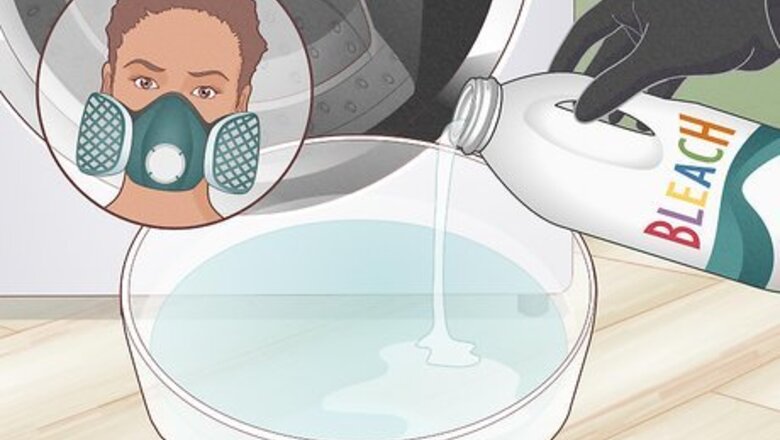
views
- Put on a respirator and gloves and mix ¾ c (180 ml) of bleach with 1 g (3.8 L) of water. Soak a cloth with the solution and wipe it inside and on top of the gasket.
- Then, let the bleach solution sit for 5-10 minutes. Wet a clean cloth with water and wipe the bleach solution off the gasket.
- Alternatively, sprinkle baking soda in the gasket and spray it with white vinegar. Scrub the ingredients with a sponge and wipe them away with a damp cloth.
Removing Mold and Mildew from the Gasket
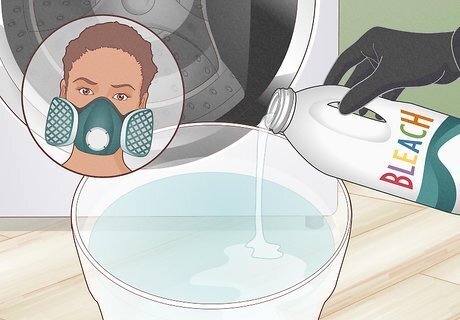
Put on a respirator and gloves, then mix bleach and water in a bucket. Bleach creates harsh fumes and can irritate your skin, so wear a respirator mask and gloves when you work with it. Move to a well-ventilated area, like your kitchen or outside, and pour ¾ cup (180 ml) of bleach into a bucket. Then, add 1 gallon (3.8 L) of warm water and mix the solution together. When mixing bleach inside, open a window or run a fan to improve airflow.
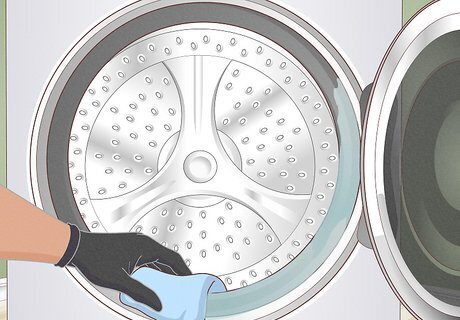
Dip a cloth in the bleach solution and wipe down the gasket. Open the washing machine door and locate the gray, rubber gasket between the door and the drum. Then, soak an old washcloth or towel in the bleach solution and squeeze out the excess moisture. Rub the cloth over the surface of the gasket and then pull the rubber apart to wipe inside the crevice. Soak the cloth in the bleach solution whenever the rag looks dirty or feels dry. If there are any clothes in your washer, take them out before you clean. Or, use sodium percarbonate (oxygenated bleach) to remove mold from the gasket. This powerful ingredient can be found in OxyClean.
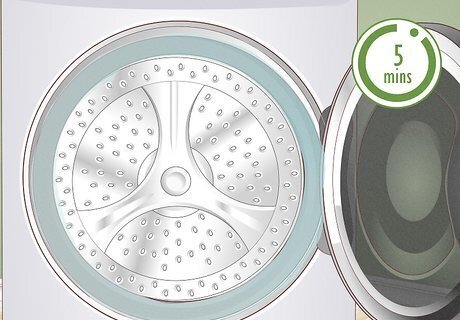
Leave the bleach solution to soak on the gasket for 5 minutes. Leaving the bleach on the gasket gives it time to kill the bacteria, black mold, mildew, and soap scum that are creating unpleasant odors. Just set a timer for 5 minutes, or 10 minutes if the gasket is covered in mold or mildew.
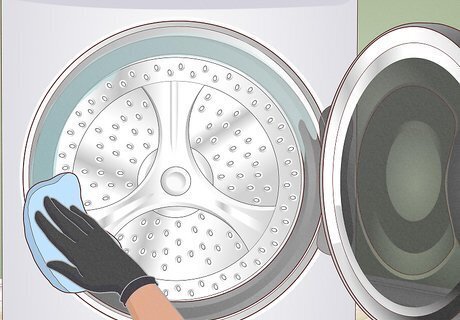
Wipe the gasket with a damp cloth to remove the bleach solution. Take a clean rag, soak it with water, and wring out the excess moisture. Then, wipe the surface and crevice of the gasket to remove the bleach and the mold or mildew residue. Inspect the gasket to ensure it’s clean, then use a dry, clean cloth to wipe the gasket completely dry. If there is still mold, mildew, or soap scum on or inside the gasket, spray the spots with the bleach solution and scrub them with a toothbrush or sponge. Leave the door open or ajar so moisture doesn't get trapped in the gasket.
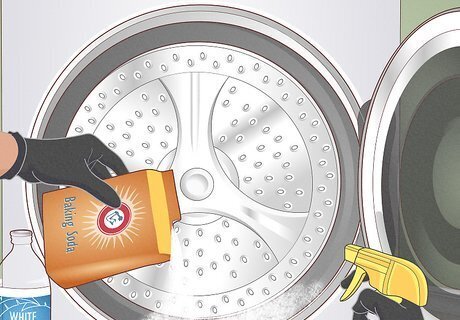
Use baking soda and vinegar if you don't want to use bleach. For a natural alternative, sprinkle baking soda in the gasket's crevice. Then, fill a spray bottle with distilled white vinegar and spray the surface of the gasket and inside the crevice. Scrub the gasket with a scrubbing sponge or toothbrush to get rid of the mold. Wipe the gasket with a clean damp cloth to rinse away the baking soda, vinegar, and debris, or run an empty washing cycle. Dry the gasket with a clean cloth after rinsing off the baking soda and vinegar. Warning: Never mix or use bleach with vinegar, baking soda, or other cleaners. Mixing bleach with other cleaners can produce harmful vapors. Note: Vinegar can damage and degrade rubber when it’s used frequently and in large quantities. Spraying the gasket monthly is unlikely to cause damage. Vinegar is generally a more effective and safer choice than bleach. It's able to kill mold and dissolve sticky soap scum.
Deep Cleaning the Drum
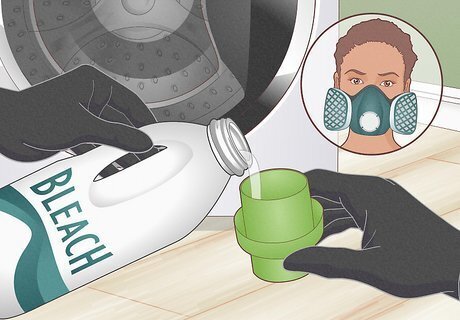
Wear a respirator, gloves, and pour bleach into the detergent cup. To protect yourself from the bleach, put on a respirator and a pair of gloves. Then, measure out 1 cup (240 ml) of bleach and pour it into the detergent dispenser. Or, place it directly inside the drum. If your detergent dispenser holds less than 1 cup (240 ml), simply pour in the bleach until it reaches the maximum line.

Use vinegar and baking soda as an alternative to bleach. If you don’t want to use bleach, distilled white vinegar and baking soda are powerful mold and mildew killers. Just pour 2 cups (473 ml) of vinegar into the detergent dispenser, or fill it up to the maximum line. Then, add ½ cup (110 g) of baking soda directly into the washer’s drum. Warning: do not mix or use bleach with other cleaners as it can cause harmful gasses.
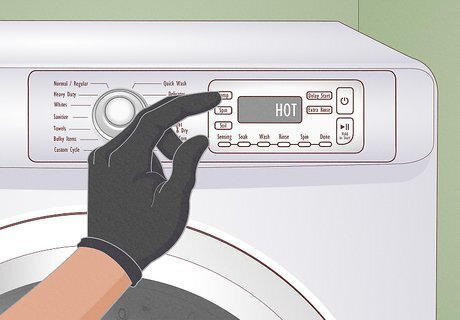
Run the washing machine on its hottest cycle. Switch on your washer and start its hottest cycle, or use your washer’s self-cleaning cycle if it has one. The combination of the cleaning agents and the high heat neutralizes odors and washes away mold, mildew, and soap scum.
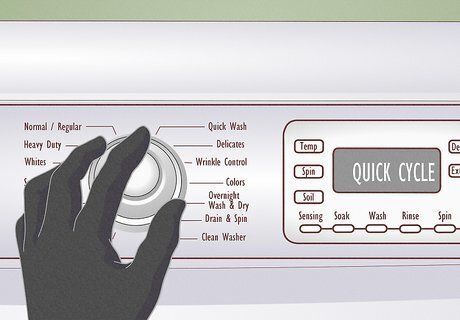
Rinse out the bleach or vinegar by running a quick spin cycle. After the washing machine finishes its heat cycle, turn it back on and run a rinse and spin cycle. This helps wash away any leftover bleach, vinegar, or baking soda residue and removes their strong odors.
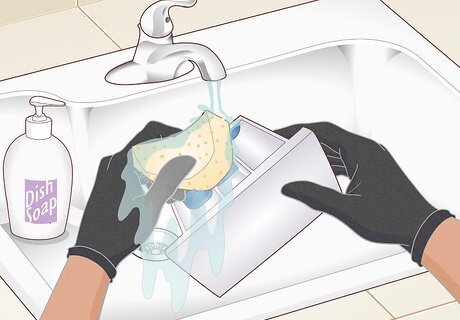
Scrub the detergent dispenser with dish soap and warm water. To remove most detergent drawers, push down on the blue or white tab at the back of the dispenser and pull out the drawer. Then, fill your sink or a bucket with warm water and a few drops of dish soap. Insert the drawer and use a sponge or soft-bristled brush to scrub off any soap scum or detergent residue inside the dispenser. If you’re not sure how to remove the detergent dispenser, check your washing machine’s user manual.
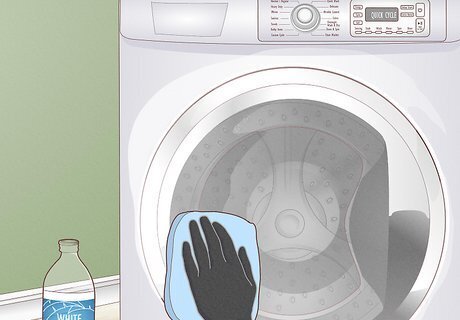
Wipe the outside of the washer with vinegar or an all-purpose cleaner. Wiping down the exterior of your washer removes any dust and dirt that might find its way inside. Just spray a clean washcloth or towel with distilled white vinegar or an all-purpose cleaner and rub it along the outside of your machine.
Preventing Mold, Mildew, & Odors
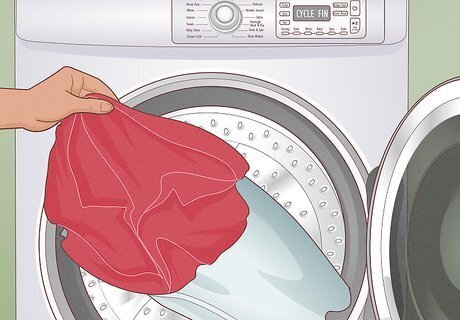
Remove wet clothes from the machine as soon as the cycle ends. Leaving your clothes in the washer can trap moisture that encourages mold, mildew, and bacteria to grow in the gasket. So, when your washer finishes its cycle, put your clothes in the dryer or hang them up to dry. If your machine beeps or makes a noise when it’s finished, make sure to turn it on so you know exactly when your clothes are done. If you left clothes in the washer and they smell like mildew, remove the smell by adding 1 cup (240 ml) of vinegar or ½ cup (110 g) of baking soda onto your clothes. Then, run the hottest cycle the clothes can handle and immediately transfer the clean clothes to the dryer.
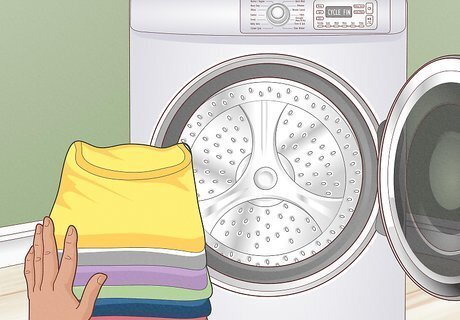
Keep the washer door open or ajar in between cycles. Closing the washing machine door after you take wet clothes out of the machine traps moisture near the gasket, which leads to mold, mildew, and odors. Instead, leave the machine door completely open to help the gasket dry out. Or, keep it cracked open to allow the moisture to evaporate. If you have small children or pets that can access the washing machine, keep the door closed to prevent any potential injuries. And for extra security, keep the door to the laundry room locked.
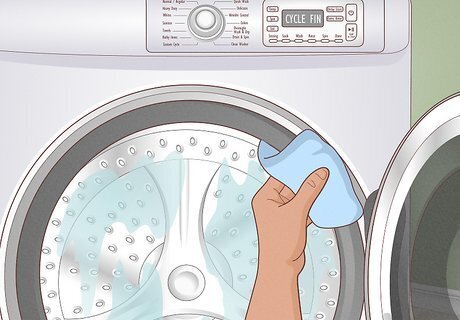
Wipe the gasket dry with a cloth after every cycle. After you take a load of clothes out of the washing machine, use a soft, clean cloth to dry the gasket. Wipe down the surface, then carefully pull the gasket back to dry inside the crevice. Use a clean cloth so you don't transfer bacteria or moisture from dirty fabric to the gasket. Front-loading washers tend to accumulate more mold and mildew because they have gaskets, unlike top-loading washers. The gasket ensures that no water leaks out of the machine during the wash cycle, but it also traps moisture that mold loves to grow in.
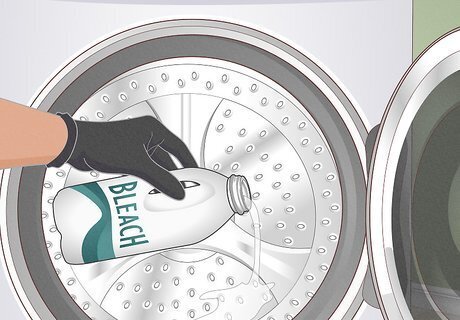
Deep clean the washer once a month to prevent bacteria from growing. Wipe down the gasket following the steps mentioned above and run the washer’s self-clean cycle if it has one. If your machine doesn't have a self-cleaning option, remove any clothes in the washer and pour 1 cup (240 ml) of bleach into the detergent dispenser or directly inside the drum. Then, run the hottest and longest cycle your machine has. After you clean the washer with bleach, run a hot rinse cycle without any clothes to remove any lingering bleach that could damage your clothes.
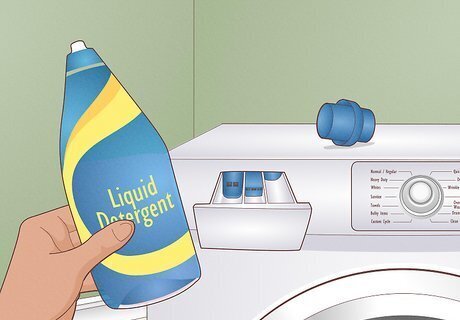
Use the recommended amount and type of detergent for your washer. Check the label on your detergent to see how much to use for different-sized washes. Using more detergent than the recommended amount creates more suds which creates more soap scum and mildew buildup. If you have a high-efficiency (HE) washer, only use high-efficiency detergent. HE washers use less water and need fewer suds, which HE detergents provide. Switch to powder detergent if possible, too. Powder detergent tends to produce fewer suds than liquid. Use dryer sheets or dryer balls instead of liquid fabric softener if you want to make your clothes smell extra nice. Fabric softener tends to leave behind residue that attracts mold and mildew.

Remove any trapped items inside the gasket. Take a few minutes every week to look for tiny items that fall out of your clothes and get trapped in the gasket. Simply pull the outside of the gasket apart and pull out items that are stuck like: Bobby pins Coins Paper clips Hair


















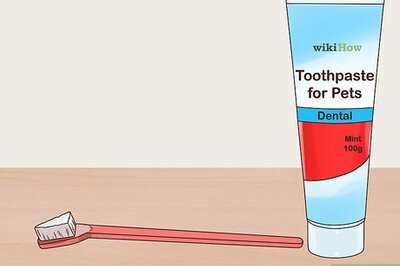

Comments
0 comment